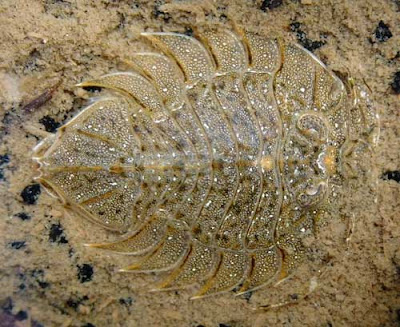19.01.2013 is even warmer than the day before: temperatures skyrocketing up to 25 or 27 °C. This is absolutely unbelievable, or at least very abnormal for Punta Arenas. The sun is also shining very hard and I got serious sunburns. I explore the same beach as the day before. I found again the large crab Peltarion spinosulum, but only dead ones. I go farther east and cross a bridge above a small river. A bit farther, I find a real rocky shore, consisting of muddy rocks with few red algae, beds of mussels and rockpools. It is not very extended as the tide amplitude is small: 2 or 3 m. I start to look between algae and below boulders. There are a lot of specimens of the small crab Halicarcinus planatus. I find large limpets and again the large sphaeromatid isopods and the gastropod similar to the European dogwhelk. Amphipods dwell between seaweeds but they only consist of small species of less than 10 mm. The real attraction of this shores are the living serolids. These large isopods (up to 35 mm) occur everywhere in rock pools, creeping on the sandy mud and sometimes burying in it. These are fascinating crustaceans because they really look like trilobites. They are one of the most remarkable example of evolutionary convergence known to me. When they feel a danger, these broad and completely flattened crustaceans can disappear in a few seconds in the sediment. I took some good pictures of them and even short films. To summarize the situation, the fauna of this rocky shore is not rich, but truly amazing for a foreign naturalist.
In the afternoon, I do a very long excursion through the town. In a street, I suddenly meet Julian Gutt, who inform me that the meeting point for tomorrow will be at 12:00 at his hotel. In Punta Arenas, the houses are small and in wood, often with a small garden, which is often protected by a metallic fence. A lot of flowers in the gardens, but of very few species. Some houses looks in poor condition. As said yesterday they are often painted in vivid colours. The walls of some houses or buildings are decorated by original wall paintings, made with very vivid colours.
In the evening, I meet my French-speaking colleagues (except Marie who was in an excursion far away, in a natural park). In a restaurant we eat santollas (Lithodes santolla), which is a big spiny lithodid crab, very superficially looking like European spider crabs but not realted to them. A bit disappointing as it as they were not as fresh as they should have been.
The next entrance of this blog will not be uploaded before several days because all or laptops will have to be checked for viruses by the IT expert of the ship. Indeed a virus spreading in the intranet of the Polarstern could be a real issue.
Patagonian sphaeromatid isopod.
The king crab Lithodes santolla is a local delicatesse in Patagonia.
(Cédric)



No comments:
Post a Comment